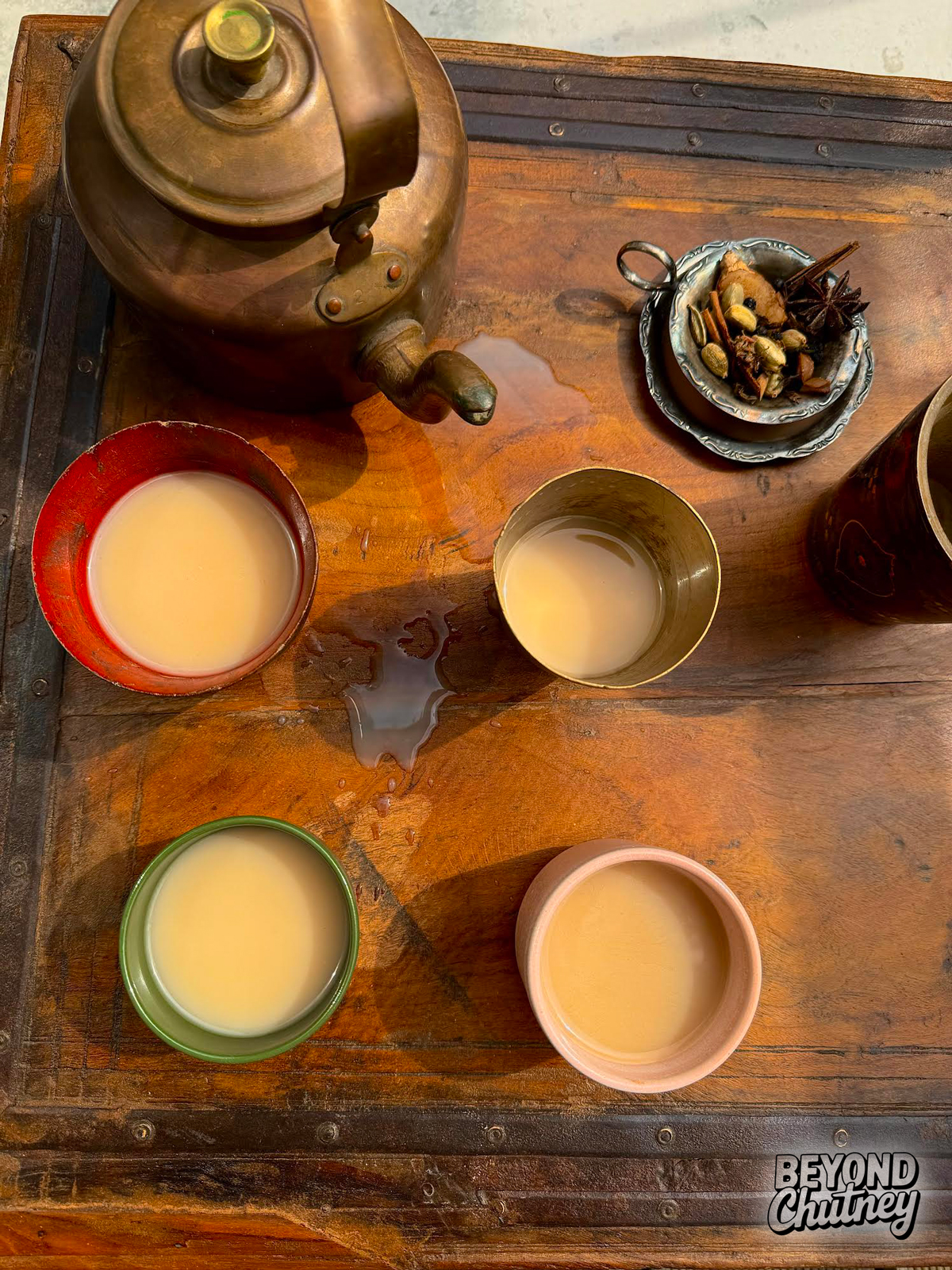
In India, masala chai is just part of life. You drink it when you're tired, when guests come over, when you need a break — or honestly, for no reason at all. There’s even a Punjabi saying: “Punjabi pani ton bina reh sakde ne, par chai ton nahin”— people can live without water, but not without chai.
Historically, chai has been around for centuries. Long before tea leaves were common, there were spiced herbal brews made with things like cardamom, cinnamon, cloves, ginger, and black pepper — believed to support digestion and overall well-being. It wasn’t until the British colonial era, when tea plantations in Assam took off, that black tea became part of the daily mix.
These days, masala chai is everywhere — from global coffee shops offering chai lattes to street vendors in India serving up cutting chai by the thousands.
One thing I never loved, though, was how overly sweet it can be. I started using dates instead of sugar — and I haven’t gone back since. The dates melt right into the chai and bring a soft, caramel-like sweetness that feels richer and more natural without being too much. It’s still spiced, still cozy — just a little gentler on the sugar.
If you already drink chai every day, try this version once for a small twist. And if you’re new to it, this is a great place to start.
Try this: If you're in the mood for something bolder, try my Masala Spiced Coffee – rich, warming, and full of depth.
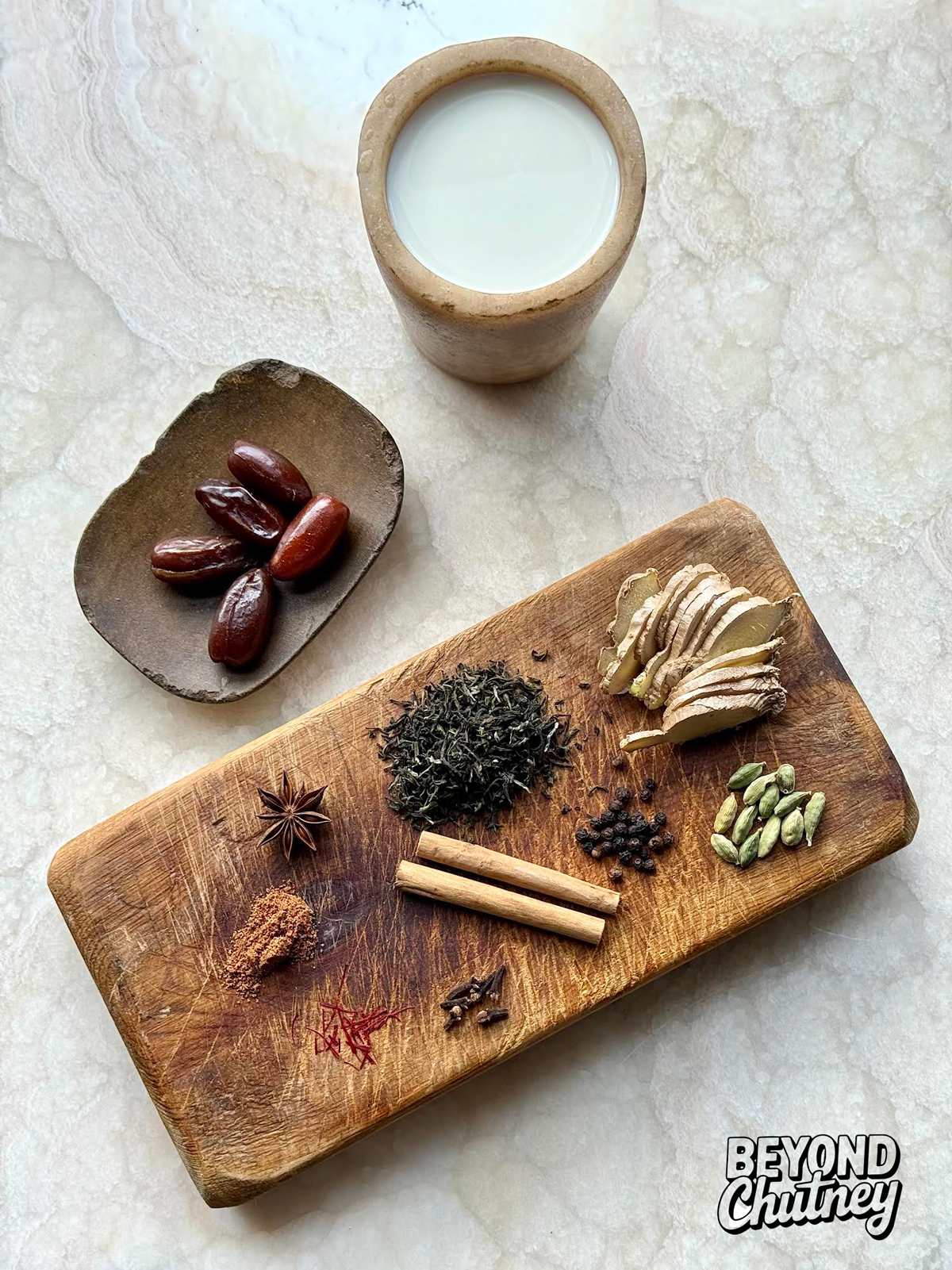
Masala Chai with Dates
Ingredients
- 2-3 tablespoon loose Assam or Darjeeling tea or 3-4 English breakfast teabags
- 12 slices fresh ginger
- 1½ teaspoon black peppercorns
- 12 green cardamom pods
- 2 cinnamon sticks
- 5 cloves
- 1 star anise adds a warm, slightly licorice-like note
- ½ teaspoon ground nutmeg optional
- 4-6 soft Medjool dates or 6–8 smaller dates, pitted and roughly chopped
- 1 liter water
- 250 ml whole milk
- Optional: 3–5 saffron strands pre-soaked in a little warm milk
Instructions
- In a large saucepan, add the water, ginger, peppercorns, cardamom, cinnamon, cloves, star anise, nutmeg, and chopped dates.
- Bring to a boil, then reduce heat and let it simmer for 10–15 minutes so the flavors and sweetness fully develop.
- Add the tea and simmer for another 3–5 minutes.
- Pour in the milk (along with the saffron and its soaking milk if using) and bring it gently to a boil again.
- Strain the chai through a fine mesh sieve into cups or a teapot.
- Serve hot and enjoy the comforting blend of spices and natural date sweetness.
Notes
- Use fresh, soft dates: Medjool dates work best because they melt easily into the chai. If your dates are a bit dry, soak them in warm water for 10 minutes before adding.
- Spice strength is flexible: Like it bolder? Add more black pepper or an extra cinnamon stick. Prefer it gentler? Use fewer cardamom pods or skip the cloves.
- No tea strainer? A fine mesh sieve works just as well to strain out the spices and tea leaves.
- Milk matters: Whole milk gives the creamiest texture, but feel free to use oat or almond milk for a vegan version. Just don't boil plant-based milk too hard—it can split.
- Make ahead tip: You can simmer the spice-and-date base in advance, then just reheat with tea and milk when you're ready for a cup.
- Want it stronger? Let the tea steep longer before adding the milk, or cover the pan while simmering to trap the heat.
- Saffron is subtle: Don’t expect it to steal the show—it just adds a delicate floral warmth in the background.
- Balance sweetness to taste: Dates vary in sweetness. If your batch isn’t quite sweet enough, add an extra one or two—or stir in a splash of date syrup at the end.
- Double or batch it: This recipe scales well! Make a big pot and keep leftovers in the fridge for up to two days. Reheat gently.
- Chai is forgiving: Forgot a spice? No stress. Masala chai is personal and flexible - you can always adjust it to suit your mood or what you have on hand.
Nutrition
Masala Chai – A Sip of History
Masala Chai has its roots in India, where it’s more than just a drink - it’s part of daily life. The original version comes from Ayurveda, using spices like ginger, cardamom and cloves for their healing properties.
Tea as we know it was added later, during British colonial times. From there, the mix of black tea, milk, and spices turned into the chai that’s now a daily ritual across Indian homes and street stalls.
Today, Masala Chai is everywhere - but the real deal is still homemade, with fresh spices and no shortcuts.
The Spices That Make It Magic
Masala Chai isn’t just about the caffeine - it’s the spices that make it special. Here are the classics:
-
Ginger – Adds heat and helps with digestion
-
Cardamom – Sweet and floral, supports metabolism
-
Cinnamon – Warm and comforting, may help balance blood sugar
-
Cloves – Strong and aromatic, great for immunity
-
Black pepper – Subtle heat, boosts absorption of other spices
In Ayurveda, this kind of spice mix is used to support digestion, boost circulation and help the body stay in balance. Each spice plays its own role, but together they form a blend that goes beyond flavor and actually supports your system.
Variations – Chai for Every Taste
There’s no such thing as one masala chai. Ask five people how they make it, and you’ll get five different answers - each with their own twist. Across India, chai isn’t just a drink, it’s a personal thing. Every family (and region) in India has their own version. These are just a few of the many ways people like to brew it:
-
Regional twists: Some use fresh mint, tulsi (holy basil), or even bay leaf.
-
Vegan chai: Swap dairy milk for oat, almond, or coconut milk - it still turns out rich and creamy.
-
Sugar-free & naturally sweet: In India, Masala Chai is almost always made with sugar - sometimes a lot of it. I swap it out for dates instead. They melt right into the brew and add a subtle caramel note. It’s a small twist, but the flavor still feels just as rich and comforting. Plus, dates bring fiber, minerals and are a little gentler on blood sugar than regular sugar.
Chai styles from across the map
-
-
Doodhpati chai – All milk, no water. Super rich and comforting, often found in northern India.
-
Noon chai – A pink, salty tea from Kashmir, brewed with green tea leaves and baking soda. Definitely not your average chai, but deeply traditional and beloved.
-
Irani chai – Creamy and sweet with condensed milk. Often served in old-school Irani cafés, perfect for dipping crispy toast.
-
Kali chai – Black tea without milk. Simple, brisk, and often preferred in the heat or after meals.
-
Masala cutting – A strong, spicy half-cup version served at street stalls in Mumbai. Small, but it hits hard.
-
Khada chamach – Literally "standing spoon"—because it’s so sweet, the spoon can stand upright in the cup. Not for the faint of heart.
-
Sulaimani chai – A spiced black tea popular in parts of Kerala and the Gulf region, usually made without milk but with lemon and cardamom. Light and aromatic.
-
Badshahi chai – Made with extra milk and served in larger glasses—rich, creamy, and indulgent. The name says it all: chai fit for royalty.
-
Western café versions - You’ve probably seen chai lattes on just about every menu these days - but let’s be honest, most of them taste more like spiced milk than real chai. Traditional masala chai is punchier, more complex, and way less sweet.
-
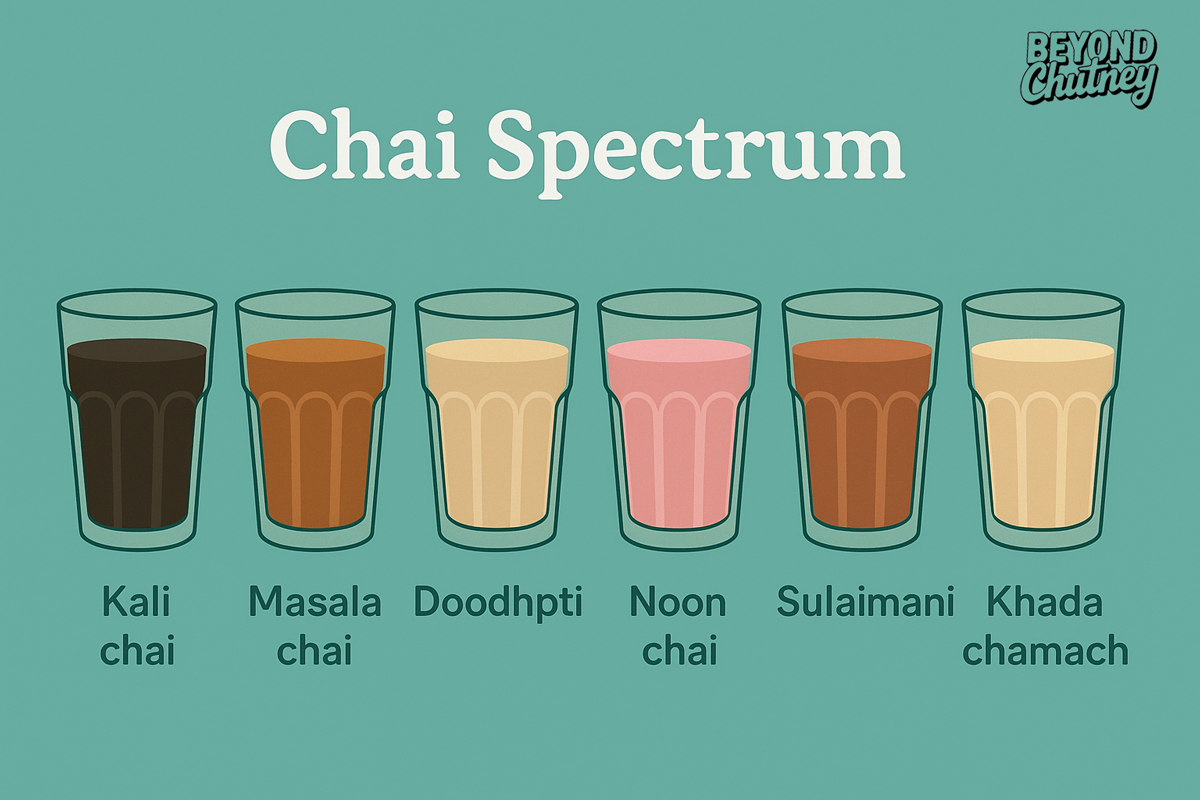
Making It – Old School or Quick Fix?
Traditionally, Masala Chai is made by boiling whole spices, tea, milk, and sweetener together until everything melds into one rich cup.
Too much work? You can batch your own spice mix ahead of time or even use a mortar and pestle to prep just enough for a few days.
And yes, there are premade chai powders and syrups - but nothing beats the aroma of fresh ginger and cardamom bubbling on the stove.
Some Facts About Masala Chai
-
"Chai" just means "tea" – So when you say "chai tea," you're basically saying "tea tea." The spiced version we all love is properly called masala chai (masala = spice blend).
-
Not ancient, actually modern – While spiced teas have a long history in India, the version with black tea, milk, and sugar became popular only in the early 20th century—partly due to British influence and Indian vendors putting their own spin on it.
-
Railway chaiwallahs made it famous – The sound of “chai, chai, garam chai!” at Indian train stations isn’t just iconic—it helped spread masala chai across the country, making it a national habit.
-
Regional secrets – In Gujarat, some add lemongrass. In Kashmir, you’ll find pink chai (noon chai) made with salt and baking soda. Every region has its own take.
-
Masala varies wildly – There’s no fixed recipe for the spice mix. Some use five spices, some ten. Common ones include cardamom, ginger, cinnamon, cloves, and black pepper.
-
Chai is social – In India, chai is more than a drink—it’s a reason to pause, talk, and connect. Many people have daily chai rituals with neighbors, coworkers, or street vendors.
More Than Just Tea – A Daily Ritual
In India, chai is a moment of pause. It’s what you offer guests, share with neighbors or grab on the go from your local chaiwallah - those street-side tea vendors who seem to know exactly how strong you like it.
Morning, afternoon, even late at night - Masla chai just fits. Sometimes it’s about catching up, sometimes it’s just quiet. Either way, it’s never really just about the tea.
Further Reading
- There’s a Lot More to Masala Chai Than Spiced Milk Tea – Epicurious
epicurious.com - The History of Masala Chai – The Spruce Eats
thespruceeats.com - What is chai — and what are the benefits of drinking it? – Washington Post
washingtonpost.com - The History of Masala Chai & How to Make Indian Masala Tea – TEALEAVES
tealeaves.com - All the Tea (Not) in China: The Story of How India Became a Tea-Drinking Nation – Serious Eats
seriouseats.com


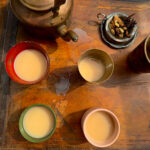
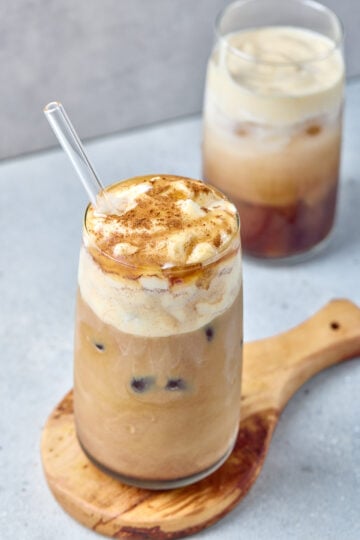
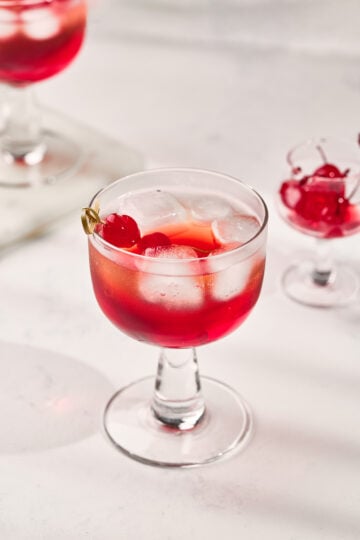
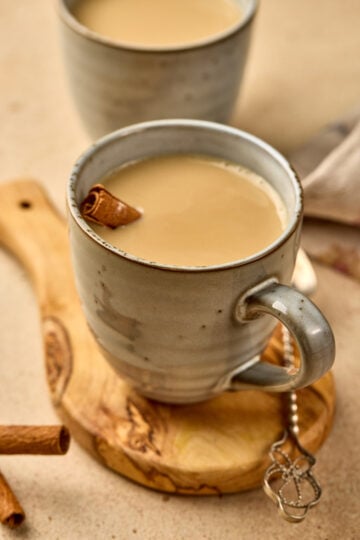
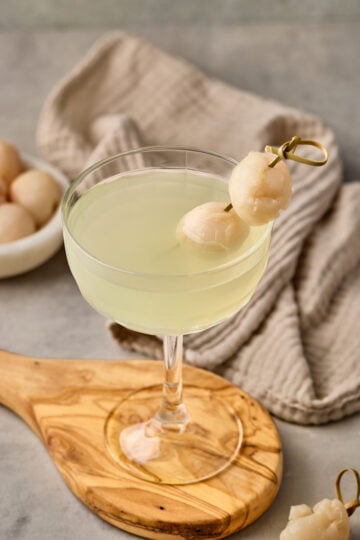
Have a question or something to share? Leave a comment below!